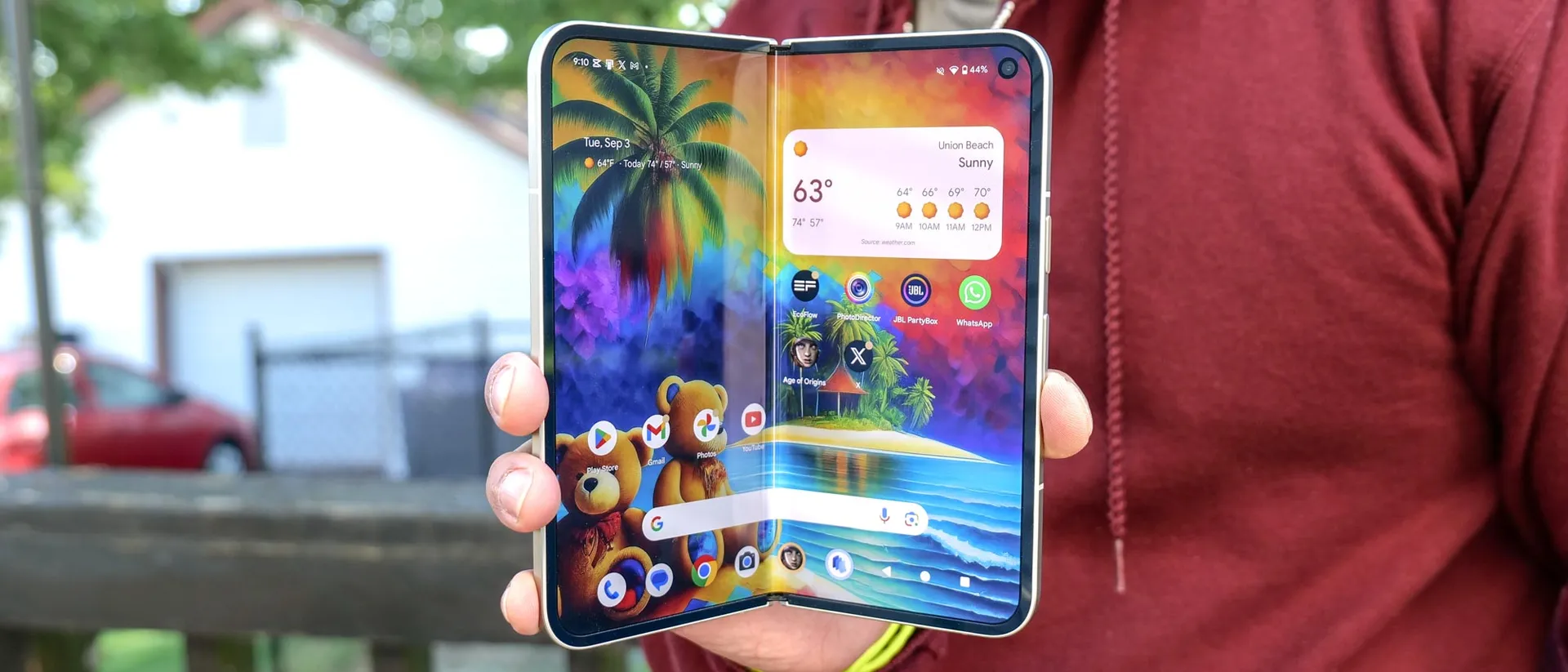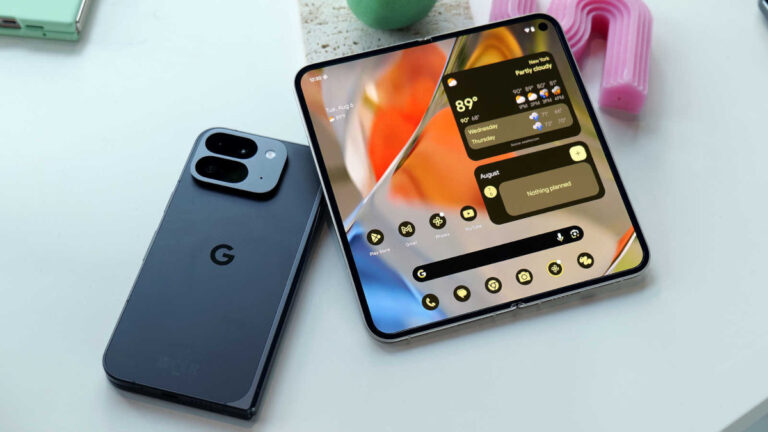Table of Contents
The Google Pixel 9 Pro Fold enters the foldable market with high expectations, building on the foundation of its predecessor while introducing notable improvements. With its expansive 8-inch display, a sleeker design, and extended battery life, the Pixel 9 Pro Fold aims to carve out a space in an increasingly competitive market. However, despite its impressive hardware, the device struggles to justify its hefty price tag, especially when stacked against rivals like the OnePlus Open.

Pros
- Larger, Brighter Display: The Pixel 9 Pro Fold boasts a stunning 8-inch OLED display, offering a superior visual experience with rich colors and sharp details.
- Enhanced Durability: Google has reinforced the design, featuring a more robust hinge and slimmer bezels, making it one of the more durable foldables available.
- Advanced AI Features: The integration of smarter AI capabilities, including improved photo editing and multitasking tools, sets the device apart from its predecessors.
- Improved Battery Life: The Pixel 9 Pro Fold offers better battery performance than its predecessor, lasting over 11 hours on a single charge.
Cons
- Mediocre Processor Performance: The Tensor G4 chip lags behind competitors like the Snapdragon 8 Gen 3, impacting overall performance.
- Limited Camera Enhancements: Despite some improvements, the camera system does not offer significant advancements over the original Pixel Fold.
- Slower Charging Speed: Charging is slower compared to the original Pixel Fold, which may be a drawback for users who need a quick power boost.

Design and Build: A Step in the Right Direction
The Pixel 9 Pro Fold’s design is a clear improvement over its predecessor. Google has addressed many of the criticisms of the original Pixel Fold, resulting in a more polished and premium feel. The new aspect ratio, sturdier hinge, and slimmer bezels make the device more ergonomic and visually appealing. The rectangular camera cutout replaces the previous horizontal bar, contributing to a cleaner and more modern look.
At just 0.2 inches when unfolded and 0.4 inches when folded, the Pixel 9 Pro Fold is one of the thinnest and lightest foldables on the market. Weighing in at 9.1 ounces, it’s comfortable to hold and use for extended periods. The IPX8 water resistance rating adds a layer of durability, although it still falls short of the OnePlus Open’s stylish design and premium construction.

Display: Bright, Vibrant, and Immersive
The display is where the Pixel 9 Pro Fold truly shines. Its 8-inch OLED panel is the largest in the U.S. market, surpassing competitors like the Samsung Galaxy Z Fold 6 and the OnePlus Open. The display delivers a crisp resolution of 2076 x 2152 pixels, with a refresh rate ranging from 1 to 120Hz, ensuring smooth scrolling and vivid visuals.
In testing, the screen reached a peak brightness of 2,319 nits, making it one of the brightest displays on a foldable device. Whether you’re watching 4K HDR content or browsing the web on a sunny day, the display performs exceptionally well, offering wide viewing angles and rich color reproduction.
The outer 6.3-inch Actua Display also impresses with its 20:9 aspect ratio, providing a more comfortable viewing experience when the device is folded. Apps fit better on the inner screen when running side-by-side, thanks to the squarer aspect ratio when unfolded.

Camera: Solid, But Not Groundbreaking
The Pixel 9 Pro Fold is equipped with a versatile camera system, featuring a 48MP main sensor, a 10.5MP ultrawide lens, a 10.8MP telephoto lens with 5x optical zoom, and a 10MP front-facing camera. While these specs are solid on paper, the real-world performance is somewhat underwhelming.
The main camera delivers reliable results in most lighting conditions, but the improvements over the original Pixel Fold are minimal. The dynamic range is similar, and while there’s less noise in shadows, the difference is negligible unless you’re closely inspecting the images.
The ultrawide camera offers a slightly wider field of view than its predecessor, making it ideal for group shots and landscapes. However, the overall image quality remains consistent with the original Pixel Fold, with no significant leaps in performance.
One of the more innovative features is the “Made You Look” mode, which uses animated cartoons on the cover screen to capture the attention of children, making it easier to snap photos of them. The “Add Me” feature, which uses AR and AI to include the photographer in the shot, is another fun addition, but it’s more of a novelty than a must-have.

Performance
Despite the inclusion of the newer Tensor G4 processor and 16GB of RAM, the Pixel 9 Pro Fold falls short in the performance department. While the device handles everyday tasks and multitasking with ease, it lags behind competitors in benchmark tests. The Tensor G4’s single-core and multi-core scores are significantly lower than those of the Snapdragon 8 Gen 3 found in the Galaxy Z Fold 6.
When it comes to gaming, the Pixel 9 Pro Fold struggles to keep up with the competition. In 3DMark’s Wild Life Unlimited test, the device averaged 55.72 fps, far below the Galaxy Z Fold 6’s 112 fps and the OnePlus Open’s 84.8 fps. While casual gaming is smooth, more demanding titles may experience frame drops and slower load times.

Battery Life: Improved, But Not Exceptional
The Pixel 9 Pro Fold is powered by a 4,650 mAh battery, slightly smaller than its predecessor’s 4,822 mAh cell. Despite this, the device manages to last 11 hours and 36 minutes in battery benchmark tests, thanks to the more power-efficient Tensor G4 chip. This is a marked improvement over the original Pixel Fold and even outlasts the Galaxy Z Fold 6.
However, charging speeds have taken a hit. The Pixel 9 Pro Fold supports 21W wired charging, which is slower than both the original Pixel Fold and the Galaxy Z Fold 6. In our tests, the device reached 38% battery in 30 minutes, compared to 47% for the original Pixel Fold.

Software: AI-Powered, But Lacking Foldable-Specific Features
The software experience on the Pixel 9 Pro Fold is largely similar to that of other Pixel 9 devices, with a few notable additions thanks to its foldable nature. Google has packed the device with AI features, such as Pixel Studio and Reimagine, which make editing photos and videos easier and more intuitive. These tools are powerful and user-friendly, setting the Pixel 9 Pro Fold apart from other foldables.
However, Google has done little to optimize the software experience specifically for a foldable device. Side-by-side app multitasking works well, but it’s nothing revolutionary. The lack of improvements in tent mode and the absence of features like the Open Canvas from the OnePlus Open make the Pixel 9 Pro Fold feel less versatile than it could be.
Final Verdict: A Foldable With Potential, But Falls Short
The Google Pixel 9 Pro Fold is a solid follow-up to the original Pixel Fold, with significant improvements in design, display, and battery life. However, its underwhelming processor performance, modest camera upgrades, and slower charging speeds make it a tough sell at $1,799. While the AI features are impressive and add value, they may not be enough to sway potential buyers, especially when more affordable and powerful options like the OnePlus Open are available.
In a market where foldable phones are no longer a novelty, the Pixel 9 Pro Fold needs to offer more than just incremental upgrades to stand out. While it’s a strong contender, it ultimately falls short of being the best foldable phone on the market.



1 Comment